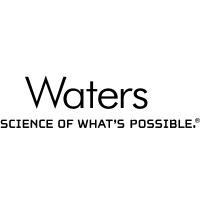
Waters Corp
NYSE:WAT


| US |

|
Johnson & Johnson
NYSE:JNJ
|
Pharmaceuticals
|
| US |

|
Berkshire Hathaway Inc
NYSE:BRK.A
|
Financial Services
|
| US |

|
Bank of America Corp
NYSE:BAC
|
Banking
|
| US |

|
Mastercard Inc
NYSE:MA
|
Technology
|
| US |

|
UnitedHealth Group Inc
NYSE:UNH
|
Health Care
|
| US |

|
Exxon Mobil Corp
NYSE:XOM
|
Energy
|
| US |

|
Pfizer Inc
NYSE:PFE
|
Pharmaceuticals
|
| US |

|
Palantir Technologies Inc
NYSE:PLTR
|
Technology
|
| US |

|
Nike Inc
NYSE:NKE
|
Textiles, Apparel & Luxury Goods
|
| US |

|
Visa Inc
NYSE:V
|
Technology
|
| CN |

|
Alibaba Group Holding Ltd
NYSE:BABA
|
Retail
|
| US |

|
3M Co
NYSE:MMM
|
Industrial Conglomerates
|
| US |

|
JPMorgan Chase & Co
NYSE:JPM
|
Banking
|
| US |

|
Coca-Cola Co
NYSE:KO
|
Beverages
|
| US |

|
Walmart Inc
NYSE:WMT
|
Retail
|
| US |

|
Verizon Communications Inc
NYSE:VZ
|
Telecommunication
|
Utilize notes to systematically review your investment decisions. By reflecting on past outcomes, you can discern effective strategies and identify those that underperformed. This continuous feedback loop enables you to adapt and refine your approach, optimizing for future success.
Each note serves as a learning point, offering insights into your decision-making processes. Over time, you'll accumulate a personalized database of knowledge, enhancing your ability to make informed decisions quickly and effectively.
With a comprehensive record of your investment history at your fingertips, you can compare current opportunities against past experiences. This not only bolsters your confidence but also ensures that each decision is grounded in a well-documented rationale.
Do you really want to delete this note?
This action cannot be undone.

| 52 Week Range |
282.7
392.01
|
| Price Target |
|
We'll email you a reminder when the closing price reaches USD.
Choose the stock you wish to monitor with a price alert.

|
Johnson & Johnson
NYSE:JNJ
|
US |

|
Berkshire Hathaway Inc
NYSE:BRK.A
|
US |

|
Bank of America Corp
NYSE:BAC
|
US |

|
Mastercard Inc
NYSE:MA
|
US |

|
UnitedHealth Group Inc
NYSE:UNH
|
US |

|
Exxon Mobil Corp
NYSE:XOM
|
US |

|
Pfizer Inc
NYSE:PFE
|
US |

|
Palantir Technologies Inc
NYSE:PLTR
|
US |

|
Nike Inc
NYSE:NKE
|
US |

|
Visa Inc
NYSE:V
|
US |

|
Alibaba Group Holding Ltd
NYSE:BABA
|
CN |

|
3M Co
NYSE:MMM
|
US |

|
JPMorgan Chase & Co
NYSE:JPM
|
US |

|
Coca-Cola Co
NYSE:KO
|
US |

|
Walmart Inc
NYSE:WMT
|
US |

|
Verizon Communications Inc
NYSE:VZ
|
US |
This alert will be permanently deleted.
 Waters Corp
Waters Corp
Waters Corp
Investor Relations
In the bustling world of life sciences, Waters Corp. stands as a pivotal player, charting its course at the intersection of science and technology. Founded in 1958, the company has carved out a niche in the development and provision of analytical instruments and software solutions. The backbone of its operations is liquid chromatography, mass spectrometry, and thermal analysis technologies. These tools are indispensable to laboratories in various sectors, including pharmaceuticals, biotechnology, food, and environmental testing. By providing cutting-edge technology to these industries, Waters Corp. ensures precise and accurate data, fundamental for research, quality control, and regulatory compliance. Each instrument is designed to address specific analytical challenges—be it the quantification of drug compounds or the detection of contaminants—thereby empowering scientists to achieve breakthroughs and maintain rigorous standards.
The financial engine driving Waters Corp. revolves around the continual demand for its high-value instruments and the recurring revenue spurred by its after-market services and consumables. Beyond the sale of its sophisticated tools, the company nurtures long-term relationships with its clients through its service offerings, which include maintenance, training, and consultation. Furthermore, consumables associated with their instruments ensure a steady stream of income; these are indispensable for daily laboratory operations. By leveraging its reputation for reliability and innovation, Waters Corp. not only fosters customer loyalty but also sustains a profitable business model, adeptly navigating the evolving landscapes of science and technology.

In the bustling world of life sciences, Waters Corp. stands as a pivotal player, charting its course at the intersection of science and technology. Founded in 1958, the company has carved out a niche in the development and provision of analytical instruments and software solutions. The backbone of its operations is liquid chromatography, mass spectrometry, and thermal analysis technologies. These tools are indispensable to laboratories in various sectors, including pharmaceuticals, biotechnology, food, and environmental testing. By providing cutting-edge technology to these industries, Waters Corp. ensures precise and accurate data, fundamental for research, quality control, and regulatory compliance. Each instrument is designed to address specific analytical challenges—be it the quantification of drug compounds or the detection of contaminants—thereby empowering scientists to achieve breakthroughs and maintain rigorous standards.
The financial engine driving Waters Corp. revolves around the continual demand for its high-value instruments and the recurring revenue spurred by its after-market services and consumables. Beyond the sale of its sophisticated tools, the company nurtures long-term relationships with its clients through its service offerings, which include maintenance, training, and consultation. Furthermore, consumables associated with their instruments ensure a steady stream of income; these are indispensable for daily laboratory operations. By leveraging its reputation for reliability and innovation, Waters Corp. not only fosters customer loyalty but also sustains a profitable business model, adeptly navigating the evolving landscapes of science and technology.





























 You don't have any saved screeners yet
You don't have any saved screeners yet
